- Problem space - the realm of the complex problem
- Data model - the constructs, operations, and constraints framing the DBMS
- Database schema - data description language
- Database engine - software implementation of the schema
- Database - instantiations of data
- User interface - software through which people work
- Middleware - a layer of software between two others (DBMS) engine and applications)
- Development tools and Application programs - task focused software
Spatial Database Systems
J Mwaura
Lecture 2: Database Principles and Architecture
Spatial Database Systems
J Mwaura
Basic Concepts of Spatial DBMS
Basic Concepts of Spatial DBMS

Classification of Database Systems
Data models - Relational, object-oriented systems, object-relational systems
Primary database functions - Data storage; transaction systems; decision support system
Nature of data - Spatial information systems; non-spatial information system
Objectives of information -Custodial systems and data warehouse; project-oriented systems
Hardware platforms and system configurations - Distributed systems; Desktop Systems
Classification of Database Systems

Approaches to Data Processing
File-based approach
- Data are stored separately in physical files
- Applications read the files directly
Data-based approach
- one (or more) physical files contain logical separators like
tables - Application reads a schema, and fetches data
File-based Approach
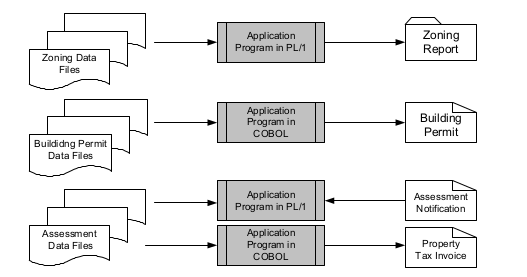
Data-based Approach
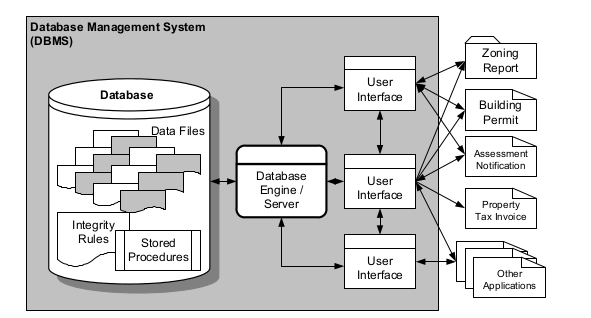
Factors for modern database systems
The desire to overcome the limitations of conventional file processing applications
To take advantage of advances in computer technology
The changing concept of using data - database stores not only data, but also a description of
the characteristics of the data and database integrity rules
Hardware and Software Architecture
Centralized and Distributed Database Architecture
Client-server computing
Database Software
Web-based Database Architecture
Centralized Database Architecture -1970's
Processing was performed on a single computer with primary memory (random access memory - RAM) and secondary memory (disk)
Access was via dumb terminal, that is terminal has no onboard memory
All input/output were performed on single host computer
Centralized Database Architecture

Distributed Database Architecture -1980-90's
Nodes - computer, operating system and database system software
Network cards - support protocols for data exchange
Communication Protocol - Transmission Control Protocol/Internet Protocol (TCP/IP)
Data Processor/Manager - Data engine for storing and retrieving data
Transaction Processor - Controls database transactions
Distributed transparency features; distribution, performance, transaction and heterogeneity
Distributed Database Architecture

Client-Server Computing - 2000's
Software runs on several client computers together with one or more servers
Client - software used for interaction with database
Application server - applications programs are stored and executed
Database server - programs for storage and retrieval of data
Client-server computing for databases
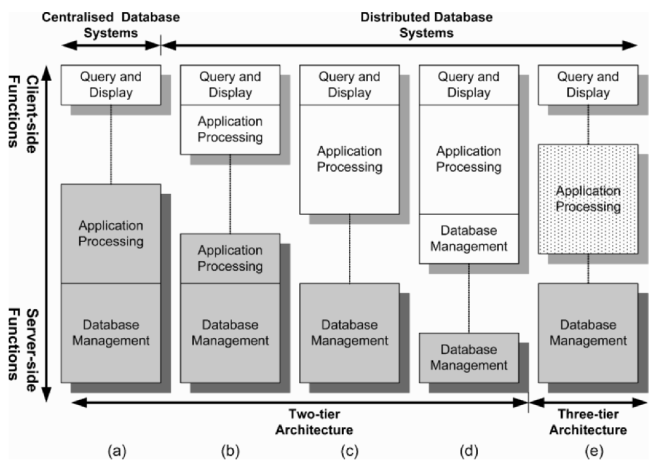
Client-Server Options
Client-Server functions are split between clients and servers
- Two tier client-server architecture(a - d)
- Three tier client-server architecture (e)
- Thin client / Fat server architecture (a & b)
- Fat clients / Thin server architecture (c & d)
Database Software - modules in database system
Database engine - operating system
SQL/NoSQL - database analysis routines
Network Middleware - client-side applications
Compiled database application interfaces - dynamic data analysis
Software modules of databases
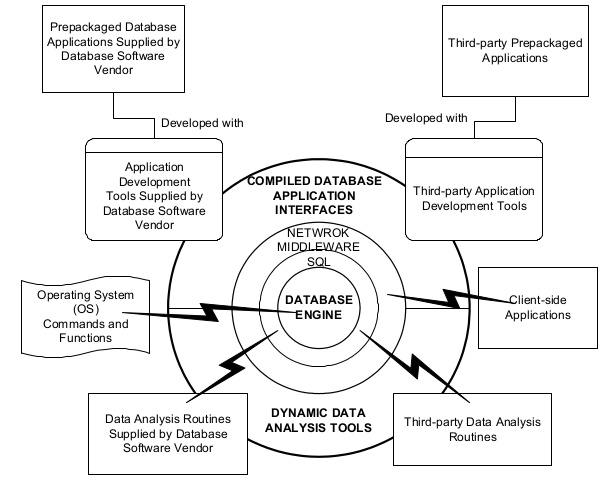
Architecture of a typical Web-based database
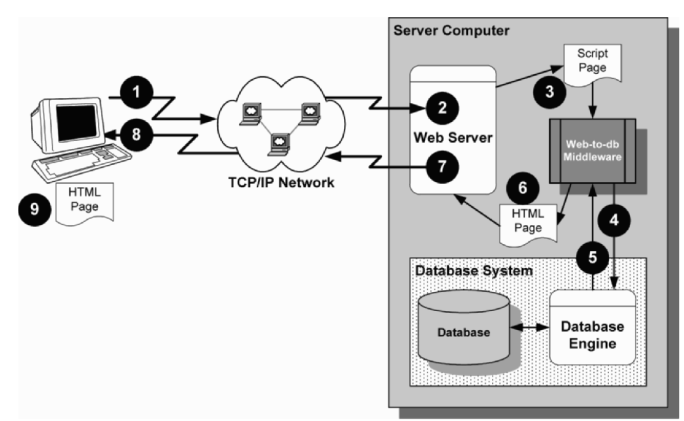
Web-based Database Architecture
Data flow as numbers indicated in previous slide
- client submits TCP/IP
packetrequest - using
hypertext markup language (HTML)embedded inhypertext transfer protocol (HTTP)which is interpreted on Web server - a script page submitted to a server-side extension, also called
web-to-database middleware - processes database queries using Common Gateway Interface (CGI) or API protocols
- queries are interpreted by database server engine
- then dynamically generates (wrapped back up) an HTML-formatted page that includes the data retrieved from database
- return to Web Server for HTTP wrapping which
- forwards the HTTP/HTML packet wrapped in TCP/IP protocol with data
- to the client that can interpret all the packaging and present the data
End of Lecture 2
Spatial Databases
That's it!
Queries about this Lesson, please send them to:
*References*
- Database Systems: Design, Implementation, and Project Management, Springer.
Albert K W Yeung & G. Brent Hall- Database Systems: Design, Implementation, and Management, 12th ed.
Carlos Coronel & Steven Morris- Database Modeling and Design; Logical Design, 5th ed.
Taby Teorey et.al- Fundamentals of database systems, 6th ed.
Ramez Elmasri & Shamkant B. Navathe
Courtesy of …